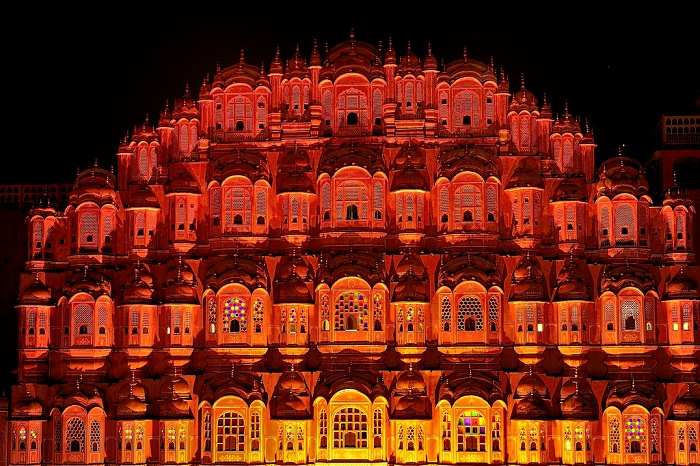Rajasthan, the desert state of India is a prime tourist destination in India. Studded with “must sees”, it can be difficult seeing it all in one go, especially if one is short on time.Travelling outside the city limits by only a few kilometers will offer a clear view of just how much influence the Rajput rulers had over the area. These journeys can afford a traveller a sense of connecting to history on a very personal level.
History is very much alive and well in Rajasthan. A stunning array of fortresses, palaces, temples, and other fortifications, the majority of which were built in the 18th century, line the hilltops to protect the area’s many villages as well as generations of royalty.
SOME OF PLACES THAT I WENT IN JAIPUR-
Hawa Mahal: Jaipur’s most iconic landmark, the red and pink sandstone facade of Hawa Mahal or Palace of Winds is widely recognized. Within its chambers, hidden from public view, the women of the royal house would secretly observe the activities on the street through the palace’s latticework openings. A fine example of Mughal architecture, the pyramidal design of Hawa Mahal rises five-storeys from the ground.
Nahargarh Fort: Set on the edge of the Aravalli Hills, Nahargarh Fort is striking in stature. Built as the summer palace for the royal family, the main palace within the fort is known as Madhavendra Bhawan. In addition, there are nine other double storied living spaces within the fort. . An example of Indo-European architectural style, royal frescos and marble engravings can still be see on the interior walls. Connected to Jaigarh Fort, the views of Jaipur city are stunning from Nahagarh Fort.

Amber Fort: The charm of Amber Fort is undeniable. Perched on a hilltop, this 15th century fort is impressive both in size and structure and can be accessed through imposing ramparts and cobbled pathways leading to its gates. Built using Mughal style architecture, the golden frontage is complemented by elaborate interiors complete with ornate archways leading to expansive chambers with hand painted and mirrorwork ceilings and walls. The fort houses the Diwan-e-Aam, or ‘Hall of Public Audience’, the Diwan-e-Khas, or ‘Hall of Private Audience’, and also the Sheesh Mahal, the ‘Mirror Palace’. The splendor of Amber Fort is heightened during the Light and Sound Show in the evening which is a must watch.
Jantar Mantar: Dating back to the 18th century, Jantar Mantar is an astronomical observation site and a testimony of the scholarly brilliance of a bygone era. Among the 20 instruments found at this UNESCO World Heritage Site, it also houses the largest sundial in the world.
City Palace: Built by Maharaja Sawai Jai Singh, the City Palace depicts typical Rajput style architecture complete with layers of chambers and halls. While a portion of the palace remains the residence of the royal family of Jaipur even today, visitors have access to other parts of the palace complex including Mubarak Mahal, Diwan-i-Khas and Maharani Palace. The City Palace also houses a museum with a fine collection of artefacts and a temple.

THINGS ONE SHOULD NOT MISS IN JAIPUR-
Visit an Elephant Camp: Located behind Amber Fort, Dera Amer is a privately owned 160-acre forest and wilderness camp. A natural habitat for elephants, camels and other domesticated animals, visitors can explore the Aravali forest on elephant back. They can also be privy to how they’re cared for and try their hand at bathing these gentle giants.
Shop for Local Handicrafts: The local bazaars of Jaipur are teeming with things to buy. Clothes, shoes, home furnishings, handicrafts, spices, jewelry and pottery…there isn’t anything you won’t love or can’t find. Some of the popular marketplaces in the city are Baapu Bazaar and Johari Bazaar. Keep your wallet handy!
Watch a Polo Match: The ‘game of kings’, polo, continues to be widely played and patronized by the upper echelons of society in Jaipur. While invites to an exclusive polo match can be hard to come by, you can watch a match at one of the city’s polo clubs like Ramgarh Resort & Polo Complex or Jaipur Polo Club, free of cost.
Block Printing at Anokhi Museum of Hand Printing: The Anokhi Museum of Hand Printing was established to preserve the age-old tradition of hand block printing. Much of Jaipur’s artisan community still practices this intricate craft. At the Anokhi Museum of Hand Printing, you can get educated about this endangered trade and witness block printing artisans at work. Visitors can also shop for locally made hand-crafted merchandise.





